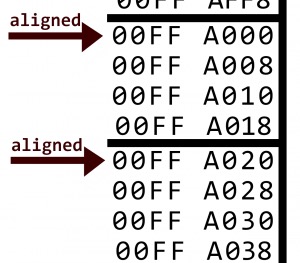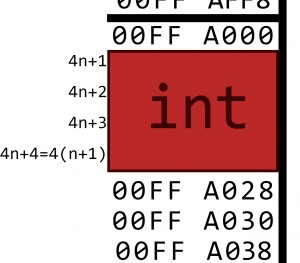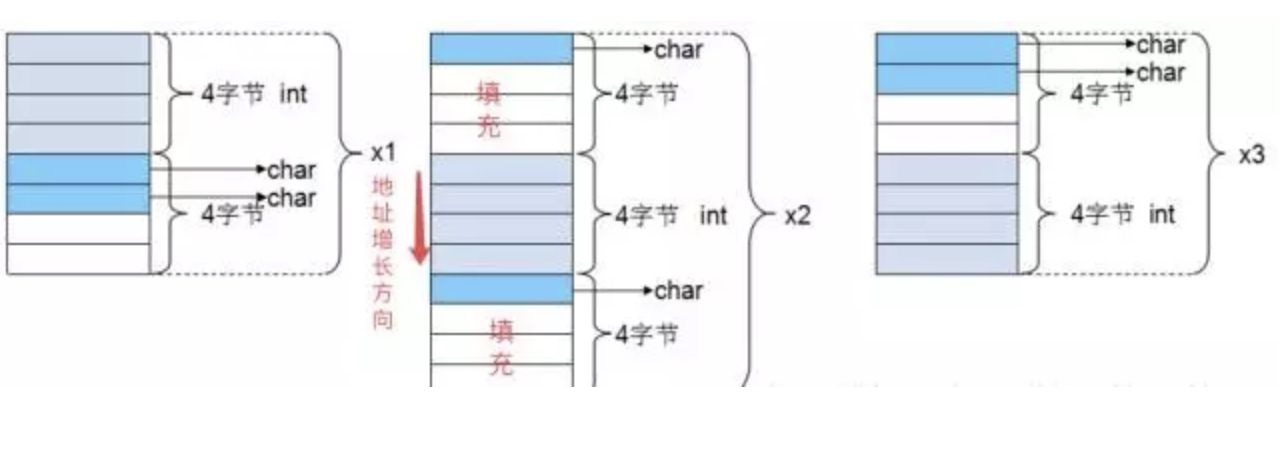Assembly Programming Tutorial
函数调用之堆栈原理(二)
C/C++内存对齐详解
Data Alignment
关于内存对齐,看我
What is data alignment? - WolfSound
memory alignment
what:
将数据排列在特定内存位置,以加快cpu访问数据的速度
a way of arranging data in memory so that it can be accessed faster by the processo
why:
cpu 按照 word(32bit and 64bit)读取数据,如果不按照特定的位置排列好数据, 一个数据耗费更多次cpu时间去读取
example:
alignment

non-alignment

how to alignment
primitive type
放置在特地位置
- short: 2 bytes (aligned to even addresses)
short:2 字节(与偶数地址对齐)
- int: 4 bytes (aligned to addresses divisible by 4)
int:4字节(对齐到可被4整除的地址)
non-primitive
add padding: 插入填充字节
1
2
3
4
5
6
7
8
9
10
11
12
13
14
15
16
17
18
19
20
21
22
23
24
25
26
27
28
|
//32位系统
#include<stdio.h>
struct
{
int i;
char c1;
char c2;
}x1;
struct{
char c1;
int i;
char c2;
}x2;
struct{
char c1;
char c2;
int i;
}x3;
int main()
{
printf("%d\n",sizeof(x1)); // 输出8
printf("%d\n",sizeof(x2)); // 输出12
printf("%d\n",sizeof(x3)); // 输出8
return 0;
}
|

command
stack frame
- rbp: stack frame bottom;
- rsp: stack frame top, chaning as stack grow;
functon call
1
2
3
4
5
6
7
8
9
10
11
12
13
14
15
16
17
18
19
20
21
|
add(int, int):
0x080483b4 <+0>: push %ebp
0x080483b5 <+1>: mov %esp,%ebp
0x080483b7 <+3>: sub $0x4,%esp
0x080483ba <+6>: mov 0xc(%ebp),%eax
0x080483bd <+9>: mov 0x8(%ebp),%edx
0x080483c0 <+12>: add %edx,%eax
0x080483c2 <+14>: mov %eax,-0x4(%ebp)
0x080483c5 <+17>: mov -0x4(%ebp),%eax
0x080483c8 <+20>: leave
0x080483c9 <+21>: ret
main:
0x080483ca <+0>: push %ebp
0x080483cb <+1>: mov %esp,%ebp
0x080483cd <+3>: sub $0xc,%esp
0x080483d0 <+6>: movl $0x2,0x4(%esp)
0x080483d8 <+14>: movl $0x28,(%esp)
0x080483df <+21>: call 0x80483b4 <add>
0x080483e4 <+26>: mov %eax,-0x4(%ebp)
0x080483e7 <+29>: leave
0x080483e8 <+30>: ret
|
2. stack
stackFrame: a stack segment;
[return address, lastBasePointer,local variable,args]
- push Next address: 将该方法执行完之后需要继续执行的指令地址压入栈中;
- jump:
1
2
3
4
5
6
7
8
9
10
11
12
13
14
15
16
17
18
19
20
21
22
23
24
25
26
27
28
29
30
31
32
33
34
35
36
37
38
39
40
41
42
43
44
45
46
47
48
49
50
51
52
|
int add(int a, int b)
{
int result = a + b;
return result;
}
int main(int argc)
{
int answer;
answer = add(40, 2);
}
```c
main;
push %ebp; #老的栈底存储起来
move %esp %ebp; #更新新的栈底值
sub $12 %esp; #栈空间增加 12byte;
mov $2 4(%esp); #2入栈
mov $40 %esp; #40入栈
call add;
mov %eax,-0x4(%ebp)
ret
add:
push %ebp; #老栈顶存起来
move %esp %ebp; #更新新的栈底值
sub $0x4,%esp
move 12(%ebp) %eax;
move 8(%ebp) %edx;
add %edx %eax; # 计算写入 %eax
move %eax (-4)%ebp
move (-4)%ebp %eax;
leave
ret
leave;
leave;
ret; #program counter
# 栈顶值更新为当前栈底;
# 栈底更新为老的;
# program counter 更新为新的指令;
move %eax (-4)%ebp #将结果写入answer
leave;
leave;
ret;
|


